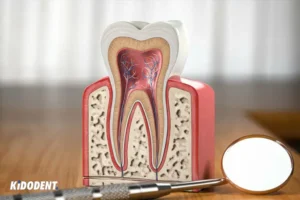Diastema is the gap between the teeth that is the result of either developing or heredity causes. People of all ages have gaps between their teeth. These gaps affect the way people’s teeth look. Diastema is normal in primary teeth of children. As an example, you see gaps between front teeth (incisors) in children. When children’s permanent teeth come out, these gaps will close.
For example, midline diastema is one of those common dental gaps in both adults and children. It is the gap between central incisors in the upper (maxillary) front teeth. Maxillary frenum may cause midline in children. In this condition, we need surgery to treat frenum. If it is not causing functional problems or it is not severe, surgery should be delayed. Usually midline will close, as children’s teeth fully erupt (lateral incisors and canines).
On the other hand, supernumerary conditions like mesiodens can cause midline diastema to be larger. Removing mesiodens is necessary to allow better eruption of teeth. Therefore, gap between midline diastema will also close.
What are the main causes of diastema?
As we said, the causes for gap between the teeth are due to either what children inherit or how they live. Sometimes, you notice how children force their tongue against their teeth or between their teeth. These kinds of habits make spaces between the teeth larger. The following are the main causes of diastema:
- Bad oral habits
- Deformities in jaw or teeth
- Overcrowded teeth (supernumerary teeth)
- Frenum problems
- Losing teeth
- Periodontal diseases
- Injuries to teeth
- Tooth irregularities
Treatment of diastema
The harmony between teeth and soft tissues in the gum can affect our smile. If the soft tissue needs improvement, surgeries like gingivectomy, grafting the gingival tissues or crown lengthening can treat the gum problems.
When the problem is from the tooth structures, variety of treatments like orthodontic appliances, prosthodontics and direct tooth restorations are available. Depending on the severity and size of the diastema, dentists offer the suitable treatment for filling the gap between your teeth.
Do you really need to treat diastema?
People always want to have a good-looking smile. Disharmony and interdental spaces in both teeth and gums can change not just smile but our behavior. Treatment offers a great harmony among adjacent teeth. You can benefit from the tooth occlusion that fits your dental stability and better function for your teeth.
You should know that by filling the gap between your teeth, your gum’s health (gingival health) also will be in a better condition, and You will be able to maintain the oral health better. Brushing teeth and flossing will not be difficult to do anymore.
What are the most popular diastema treatments?
One of the restorative treatments for diastema is composite resin bonding. Composite is fast and less expensive compared with other restoratives that are made in laboratories. Patients usually need one visit for treating their interdental spaces.
The best way to close diastema in small gaps is using microfilled composite resin. However, dentists use nanofilled and microhybrid composite resin for larger diastema (more than 1.5 mm gap).
The other popular diastema treatment is porcelain veneers (laminate veneers). Porcelain veneers may need more time and money since these restorations are made in the laboratory. Porcelain veneers can treat larger diastema. If there are many interdental spaces, these laboratory-made veneers can offer great closure for your dental gaps.
The final tip is having the most beautiful look for your teeth. Following oral health instructions daily can give us the pleasing result for our diastema restorations.[1]
